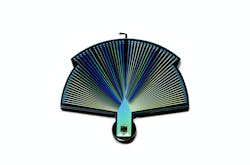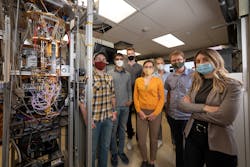NASA team’s PEACOQ quantum detector is a ‘leap’ forward
Quantum communications use pulses of light at the single-photon level and, because it’s crucial to send this information at the highest data rate possible, this is why a high-speed single-photon detector is required to detect and precisely measure photon arrival times.
This inspired a team of NASA researchers led by Matthew D. Shaw at NASA’s Jet Propulsion Laboratory (JPL) to create a better detector for space-to-ground quantum communications. They designed a quantum detector called “PEACOQ,” which is short for performance-enhanced array for counting optical quanta (see video and Fig. 1).
“If you’re encoding information in the arrival time of a photon, which is done in time-bin encoding protocols, your timing precision determines how closely you can space your time bins together,” says Ioana Craiciu, a postdoctoral scholar and researcher on the PEACOQ team. “This, in turn, determines your clock rate—and, ultimately, your data rate.”
PEACOQ is the fastest known single-photon detector, with a maximum count rate of 1.5 GHz. Combined with a timing resolution below 100 ps, it’s a quantum leap for the field that’s—until now—been somewhat limited by the speed and efficiency of available detectors.
PEACOQ design
Improving quantum transmission rates requires a photon detector that can count photons fast as they arrive in rapid succession—and precisely measure their arrival times.
To address this need, the researchers designed the PEACOQ quantum detector, which is only 13 µm across, with 32 superconducting nanowires (each a mere 7.5 nm thick) from a thin sheet of niobium nitride (NbN), on a silicon chip.
When cooled to below 1 K (-458°F), the nanowires become superconducting and have no electrical resistance. When photons hit the wire and are absorbed by it, they stop superconducting—which enables the single-photon detection mechanism.
“We bias these nanowires with a DC current, and when one of the nanowires absorbs a photon, a resistive hotspot is formed that kicks the current out of the nanowire and into the readout electronics where it’s registered as a pulse and time-tagged,” says Craiciu.
After a photon is detected by one of the nanowires, a short “dead time” of around 5 ns occurs because the current in the nanowire needs to reset. During this time, the nanowire can’t detect another photon.
To tackle this issue, the team coupled PEACOQ’s array of 32 nanowires to one single-mode optical fiber, “so when one nanowire is momentarily out of commission, the other 31 nanowires are still able to detect photons,” Craiciu explains. “This reduces the effective dead time of PEACOQ significantly, and is part of what allows it to measure single photons at count rates above 1 giga-count per second.”
They also developed a new time-to-digital converter to measure up to 128 channels at once with a timing resolution of tens of picoseconds to support the detector’s 32 channels.
Another key aspect of designing a “fast” detector is precisely measuring the arrival time of the photons, which is inversely related to the timing jitter. “We made several design choices to reduce the jitter, including the material we made the nanowires from (NbN),” she points out. “We also made the nanowires short, which decreases geometric jitter—an uncertainty in the arrival time of the photon that comes from not knowing where along the nanowire the photon was absorbed.”
One final big hurdle for the researchers: the two ‘fast detector’ metrics, count rate and timing jitter, aren’t independent. “At higher count rates, jitter gets worse due to the time-walk effect,” says Craiciu. “Our group has shown, with PEACOQ and in related work, this effect can be compensated by using calibration—either in post-processing or in hardware while collecting data.”
Putting PEACOQ to the test
The team demonstrated PEACOQ by cooling it to 1 K inside a cryostat and using a custom-built setup to send light to it, as well as a chain of electronics to transmit the detector’s output signal out of the cryostat to amplify and record it (see Fig. 2).Since PEACOQ has 32 nanowires, they needed 32 sets of each component, and 32 of each kind of amplifier.
The researchers were happy to discover how well it worked—PEACOQ makes it possible to perform quantum communications with a state-of-the-art clock frequency of 10 GHz. It achieved an efficiency rate of around 80%, which means 20% of the photons hitting the detector aren’t measured. They’re now working to make the detector even more efficient.
Backstory behind PEACOQ’s name
One of the coolest aspects of this quantum detector, beyond counting photons so fast, is its distinctive plumage—and the backstory behind its name.
“At NASA we love a backronym, so when we beheld this beautiful detector with a small round body and a large fan, we knew what we had to call it,” says Craiciu. “It’s not just the shape, either! Like a peacock feather, the PEACOQ chip’s color shifts from blue to green as you move it under light, which is due to the dielectric stack on top of the nanowires.”
The really neat thing, Craiciu points out, is all of these features arose from practical considerations. “The round body is designed to self-align to an optical fiber,” she explains. “And the fan shape is needed to send 64 on-chip transmission lines from the nanowires to the edge of chip, where we can wire-bond and electrically connect the nanowires to our readout electronics. And the dielectric stack is a distributed Bragg reflector that’s combined with a gold mirror below the nanowires to create an optical cavity that boosts the PEACOQ detector efficiency to around 80%.”
Path forward for PEACOQ
When creating PEACOQ, the team had quantum communications in mind and their work is an extension of NASA’s Space Communications and Navigation program.
“Both space-to-ground classical optical communication and quantum communication need efficient detectors to measure single telecommunication wavelength photons at high count rates with high timing precision,” Craiciu says. “We’d love to hear about other applications that need this type of fast single-photon counting detector.”
The team hopes their detector will find uses beyond quantum communications. If anyone out there in the broader scientific and engineering community—other quantum information subfields or totally different fields such as biology, life sciences, or astronomy—thinks they can do cool experiments with PEACOQ, go ahead and reach out.
Next, the group wants to continue their work with PEACOQ in two directions. “The first is to make a testbed equipped with PEACOQ detectors that can be used to measure photons in real-world applications,” she says. “This involves fabricating the next batch of detectors and also building a cryostat complete with readout electronics. And we’d also like to make improvements to our readout system to fully take advantage of the detector’s low jitter.”
FURTHER READING
I. Craiciu et al., Optica, 10, 2, 183–190 (2023); https://doi.org/10.1364/optica.478960.
About the Author
Sally Cole Johnson
Editor in Chief
Sally Cole Johnson, Laser Focus World’s editor in chief, is a science and technology journalist who specializes in physics and semiconductors.



